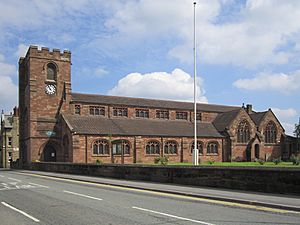St Thomas' Church, Ashton-in-Makerfield facts for kids
Quick facts for kids St Thomas' Church, Ashton-in-Makerfield |
|
|---|---|

St Thomas' Church, Ashton-in-Makerfield, from the south
|
|
| Lua error in Module:Location_map at line 420: attempt to index field 'wikibase' (a nil value). | |
| OS grid reference | SJ 577,990 |
| Location | Warrington Road, Ashton-in-Makerfield, Greater Manchester |
| Country | England |
| Denomination | Anglican |
| Website | St Thomas, Ashton-in-Makerfield |
| History | |
| Status | Parish church |
| Consecrated | 6 July 1893 |
| Architecture | |
| Functional status | Active |
| Heritage designation | Grade II |
| Designated | 7 December 1966 |
| Architect(s) | F. H. Oldham, Henry Paley |
| Architectural type | Church |
| Style | Gothic Revival |
| Groundbreaking | 1891 |
| Completed | 1930 |
| Specifications | |
| Materials | Stone |
| Administration | |
| Parish | St Thomas, Ashton-in-Makerfield |
| Deanery | Wigan |
| Archdeaconry | Warrington |
| Diocese | Liverpool |
| Province | York |
St Thomas' Church is located on Warrington Road in Ashton-in-Makerfield, Greater Manchester, England. It is an active Anglican parish church, which means it serves the local community. The church is part of the Anglican Diocese of Liverpool. It is also a Grade II Listed building, meaning it is an important historical building that is protected.
Contents
History of St Thomas' Church
A smaller church, called a chapel of ease, was first recorded on this spot in 1515. This early chapel was rebuilt in 1714. It had a cross-shaped design and was officially opened, or consecrated, in 1746. The chapel was made larger in 1782 and again in 1815. This older building was built in the Georgian style.
The church you see today was built between 1891 and 1893. It was designed by an architect named F. H. Oldham from Manchester. The new church could seat about 500 people. It was consecrated on July 6, 1893, by the Bishop of Liverpool at that time, J. C. Ryle. Later, in 1929–1930, a new room called a vestry was added. This addition was designed by Henry Paley, an architect from Lancaster. The church tower originally had a special type of roof called a saddleback roof, but this was removed in the 1960s.
Architecture and Design
Outside the Church
St Thomas' Church is built from stone and has a concrete tile roof. The church's layout includes a main central area called a nave with three sections, and a row of windows above it called a clerestory. On either side of the nave are narrower sections called aisles. At the front is the chancel, where the altar is, with a room for the organ on the north side. There are also vestries (rooms for clergy and choir) to the south and east. A tall tower stands at the west end of the church.
The tower has entrances on its north and south sides. It also features a large window on the west side with decorative stone patterns called tracery. At the northwest corner of the tower, there is a small stair turret. The openings for the bells have wooden slats, known as louvred openings. There are clock faces on three sides of the tower. The top edge of the tower has a parapet with a battlement design, like a castle wall. You can also see a gargoyle on the east side. Along the sides of the south aisle, there are pairs of windows, while the north aisle has windows with one or two sections. The clerestory windows mostly have three sections.
Inside the Church
Inside St Thomas' Church, the arcades (rows of arches) are supported by eight-sided piers (large columns) that do not have decorative tops, known as capitals. The arch leading into the chancel is decorated with Tudor roses. On the north side of the chancel, there is a piscina, which is a basin used for washing sacred vessels.
Some items from the older church building were moved into the new one. These include a large hanging light fixture (chandelier), the decorative case for the organ from 1826, and the Royal arms of King William IV. There are also monuments inside the church that date back to the 18th century. Most of the beautiful stained glass windows were created by an artist named A. L. Moore. This includes the large east window from 1897, which celebrates Queen Victoria's Diamond Jubilee.
The church's pipe organ was originally built in 1826 by Bewsher and Fleetwood. It was updated in 1890 and then moved into the new church in 1905, where it was rebuilt by Charles Whiteley. In 1962, the organ was moved again to a different chapel within the church. It was last updated in 1988 by George Sixsmith.
Churchyard and Memorials
The churchyard around St Thomas' Church contains the graves of service personnel who died in wars. There are eight war graves from the First World War and three from the Second World War in the main churchyard. In an extension of the churchyard, located on Heath Lane, there are ten more war graves from the First World War and four from the Second World War. These graves serve as memorials to those who served their country.
See also
- Listed buildings in Ashton-in-Makerfield
- List of churches in Greater Manchester
- List of ecclesiastical works by Austin and Paley (1916–44)

